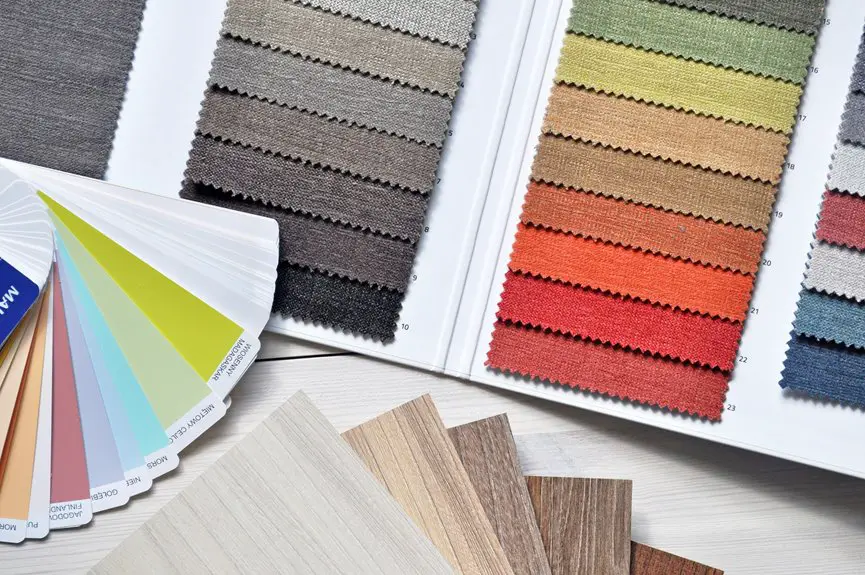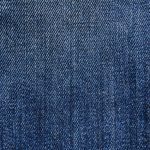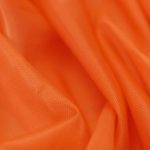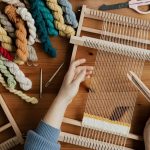You’ll find spunbond fabrics are made by bonding continuous synthetic fibers with heat, giving you a durable, strong, and somewhat firm material ideal for heavy-duty uses like medical gowns or crop covers. Spunlace, on the other hand, uses water jets to entangle fibers, creating a softer, more flexible fabric perfect for wipes and hygiene products. Each has distinct textures, strengths, and costs, so if you keep exploring, you’ll understand how to pick the best fit for your needs.
Table of Contents
Key Takeaways
- Spunbond uses thermal bonding of synthetic fibers, creating strong, durable fabrics with a firm texture, while spunlace uses hydroentanglement for softer, pliable fabrics.
- Spunbond fabrics are stronger and more tear-resistant, suitable for heavy-duty applications; spunlace offers moderate strength with superior softness for comfort.
- Spunbond has a flat, consistent surface texture, whereas spunlace features a detailed, embossed-like tactile surface.
- Spunbond is commonly used in medical gowns, agricultural covers, and reusable bags; spunlace is favored for hygiene products like wipes and diapers.
- Spunbond manufacturing consumes less water and costs less, while spunlace biodegrades faster but requires more water and has a higher production cost.
What Are Spunbond Fabrics?
Spunbond fabrics are lightweight, durable nonwoven materials made by directly bonding continuous filaments. When you work with spunbond fabrics, you’ll notice their strength and resistance to tearing.
These fabrics are produced by extruding molten polymers into thin filaments, which are then laid randomly onto a conveyor belt and bonded through heat or pressure. You’ll find spunbond fabrics used in medical gowns, agricultural covers, and geotextiles because they offer excellent breathability and filtration while maintaining durability.
Molten polymers form thin filaments, bonded by heat or pressure, creating breathable, durable spunbond fabrics for diverse uses.
Since they’re made from continuous fibers, spunbond materials don’t shed lint and provide consistent performance. You can rely on their smooth surface and uniform structure for various applications, especially where durability and lightweight features are essential.
These qualities make spunbond fabrics a popular choice across many industries.
Understanding Spunlace Fabrics
Although spunlace fabrics share some similarities with other nonwovens, they stand out because of their unique manufacturing process, which uses high-pressure water jets to entangle fibers.
This technique gives spunlace fabrics a soft, cloth-like feel and excellent strength, making them versatile for many uses.
When you choose spunlace fabric, you’ll appreciate its:
- Breathability and absorbency, ideal for hygiene and medical products
- Durable yet flexible texture, perfect for wipes and cleaning cloths
- Eco-friendly nature, often made from natural or recycled fibers
You’ll find spunlace fabrics in everything from baby wipes to face masks because they combine comfort with functionality.
Their gentle touch and reliable performance make them a smart choice when you need a nonwoven fabric that won’t irritate the skin or fall apart quickly.
Manufacturing Processes of Spunbond and Spunlace
You’ll find that spunbond fabric production involves melting polymers and extruding them into continuous filaments, which are then laid into a web and bonded.
On the other hand, spunlace fabric formation uses high-pressure water jets to entangle fibers, creating a soft, strong nonwoven.
Let’s explore how these distinct processes shape the properties of each fabric type.
Spunbond Fabric Production
Discover how continuous filaments transform into durable, lightweight nonwoven fabrics through a streamlined production process.
In spunbond fabric production, thermoplastic polymers like polypropylene are melted and extruded through spinnerets to create fine, continuous filaments. These filaments are then rapidly cooled, stretched, and laid down onto a moving conveyor belt, forming a web.
You’ll see this web bonded using heat and pressure to create a strong, uniform fabric.
Key steps include:
- Extrusion: Melting and spinning polymers into filaments.
- Web Formation: Laying filaments into a web on a conveyor.
- Thermal Bonding: Applying heat and pressure to bond filaments.
This efficient process delivers fabrics with excellent strength and versatility, perfect for medical, hygiene, and industrial uses.
Spunlace Fabric Formation
Spunlace fabric forms by entangling fibers with high-pressure water jets, creating a soft, strong, and flexible material without using adhesives or thermal bonding. You’ll see that this hydroentanglement process mechanically bonds fibers, preserving their natural properties and enhancing fabric drape and softness. Compared to spunbond, spunlace offers superior absorbency and texture, making it ideal for wipes and medical textiles.
| Aspect | Spunlace Fabric |
|---|---|
| Bonding Method | Hydroentanglement (water jets) |
| Texture | Soft, flexible, and drapable |
| Key Benefits | Strong, absorbent, no adhesives used |
Key Material Differences Between Spunbond and Spunlace
You’ll notice that spunbond and spunlace fabrics use different fiber types and bonding methods, which directly impact their texture and strength.
Understanding these material differences helps you choose the right fabric for your needs.
Let’s explore how these factors set spunbond and spunlace apart.
Fiber Types Used
Fiber selection plays an essential role in defining the characteristics of spunbond and spunlace nonwoven fabrics.
When you’re choosing fibers, you’ll notice spunbond fabrics typically use synthetic fibers, which gives them strength and durability. On the other hand, spunlace fabrics often employ a mix of natural and synthetic fibers, offering softness and absorbency.
Here’s what you should consider about fiber types:
- Spunbond: Mostly polypropylene or polyester for toughness and resilience.
- Spunlace: Commonly uses cotton, viscose, or polyester blends for softness and flexibility.
- Blends: Both can include fiber blends to balance properties like strength, absorbency, and texture.
Understanding these fiber choices helps you select the right fabric for your specific application needs.
Bonding Techniques Employed
Although both spunbond and spunlace fabrics serve various applications, they rely on distinctly different bonding techniques that impact their texture and strength.
When you work with spunbond fabric, you’ll find the fibers are bonded through heat and pressure. This thermal bonding fuses continuous filaments, creating a stable and durable web.
On the other hand, spunlace fabric uses hydroentanglement, where high-pressure water jets entangle fibers mechanically. This method doesn’t involve adhesives or heat, making the fabric softer and more pliable.
So, if you need durability and firmness, spunbond’s thermal bonding works best. But for a softer, more flexible feel, spunlace’s water jet bonding is your go-to.
Understanding these bonding techniques helps you choose the right fabric for your specific needs.
Texture and Strength Differences
Since spunbond and spunlace fabrics use different bonding methods, their texture and strength vary considerably.
When you choose between these two, understanding their physical characteristics helps you pick the right fabric for your needs.
- Spunbond offers a smoother, more rigid texture because its fibers are thermally bonded, making it strong and durable for heavy-duty uses.
- Spunlace feels softer and more fabric-like due to its hydroentanglement process, giving it a flexible texture but less tensile strength.
- Strength-wise, spunbond excels in tear and burst resistance, while spunlace provides moderate strength with superior softness and drape.
Knowing these differences, you can select spunbond for durability or spunlace when softness and flexibility matter most.
Durability and Strength Comparison
When you compare spunbond and spunlace nonwoven fabrics, you’ll notice that their durability and strength vary considerably due to their distinct manufacturing processes. Spunbond fabric is created by bonding continuous filaments, giving it higher tensile strength and resistance to tearing. Spunlace, produced by hydroentangling fibers, offers moderate strength but excels in flexibility and softness. Choosing between them depends on your application’s demands for durability versus comfort.
| Feature | Spunbond |
|---|---|
| Tensile Strength | High |
| Tear Resistance | Excellent |
| Flexibility | Moderate |
| Feature | Spunlace |
| Tensile Strength | Moderate |
| Tear Resistance | Good |
| Flexibility | High |
Texture and Feel: How They Differ
When you touch spunbond fabric, you’ll notice its slightly rougher surface compared to spunlace.
Spunlace feels softer and more comfortable against your skin, thanks to its finer fibers and water-jet bonding process.
Understanding these differences helps you choose the right fabric for your needs.
Surface Texture Comparison
Although both spunbond and spunlace nonwoven fabrics serve various applications, you’ll notice distinct differences in their surface textures.
Spunbond fabrics have a smoother, more uniform surface due to their continuous filament structure. In contrast, spunlace fabrics exhibit a more intricate and patterned texture created by high-pressure water jets entangling the fibers.
When comparing the two, consider these key points:
- Spunbond offers a flat, consistent feel with minimal texture variations.
- Spunlace showcases a visibly detailed, embossed-like surface with a textured pattern.
- The tactile complexity in spunlace makes it more visually interesting compared to the simpler spunbond fabric.
Understanding this helps you select the right fabric based on the desired surface appearance and texture for your specific needs.
Softness and Comfort Levels
Softness plays an essential role in how comfortable nonwoven fabrics feel against your skin.
When you touch spunbond fabric, you’ll notice it’s firmer and less pliable, making it suitable for applications where strength matters more than softness.
On the other hand, spunlace fabrics offer a much softer, smoother texture because of their hydroentanglement process, which gently bonds fibers without adhesives. This gives spunlace a more cloth-like feel, making it ideal for products that require direct skin contact, like wipes and medical dressings.
If comfort is your priority, spunlace will likely feel more pleasant and gentle. However, if durability with moderate softness works for your needs, spunbond might be enough.
Understanding these differences helps you choose the right fabric for your specific comfort requirements.
Common Applications for Spunbond Fabrics
Since spunbond fabrics offer durability and breathability, you’ll find them used in a wide range of industries. Their strength and lightweight nature make them ideal for applications where long-lasting performance is key.
When you need reliable material, spunbond is a smart choice.
Here are some common applications for spunbond fabrics:
- Medical supplies: You’ll see spunbond in surgical gowns, masks, and drapes because it provides protection without sacrificing comfort.
- Agriculture: Farmers use spunbond fabrics as crop covers and weed barriers to protect plants while allowing air and moisture to pass through.
- Packaging: Spunbond materials are perfect for reusable bags and protective packaging that require toughness and breathability.
Typical Uses for Spunlace Fabrics
Spunlace fabrics bring a different set of qualities that make them suitable for applications where softness and absorbency matter most.
When you choose spunlace, you get a fabric that’s gentle on the skin, making it perfect for personal care products like wet wipes and facial masks.
You’ll also find spunlace used in medical settings—for example, surgical gowns and wound dressings—because it offers both comfort and breathability.
If you’re in the cleaning industry, spunlace wipes are effective and durable, ideal for household and industrial use.
Additionally, spunlace fabrics work well in hygiene products such as baby diapers and sanitary napkins due to their excellent liquid retention.
Environmental Impact and Sustainability Considerations
Although nonwoven fabrics like spunbond and spunlace offer many practical benefits, their environmental impact deserves close attention. When you choose between these fabrics, consider how their production and disposal affect sustainability.
Spunbond fabrics, made from thermoplastic polymers, typically consume less water but rely on fossil fuels. Spunlace, often made from natural fibers or blends, uses more water but may biodegrade faster.
Keep these points in mind:
- Spunbond’s lower water use reduces strain on resources, but its plastic content can persist in landfills.
- Spunlace’s biodegradability can lessen long-term waste but may require more energy and water to produce.
- Recycling options for both materials remain limited, so disposal methods impact overall environmental footprint.
Understanding these factors helps you make greener fabric choices.
Cost Factors and Availability of Spunbond vs. Spunlace
When you compare spunbond and spunlace fabrics, cost and availability play crucial roles in your decision.
Spunbond fabric generally costs less because its manufacturing process is faster and less labor-intensive. It’s widely available due to large-scale production, making it easier for you to source in bulk.
On the other hand, spunlace fabric tends to be pricier since it requires a more complex hydroentanglement process, which increases production time and costs. Availability can be more limited, especially for specialized applications, so you might face longer lead times.
Spunlace fabrics cost more due to complex hydroentanglement and often have limited availability with longer lead times.
If budget and quick access are priorities, spunbond often fits better. But if you need superior softness and strength, investing in spunlace could be worth the extra cost and wait.
Knowing these factors helps you balance quality with practicality.
Frequently Asked Questions
Can Spunbond and Spunlace Fabrics Be Recycled Together?
You can’t usually recycle spunbond and spunlace fabrics together because they’re made differently. You’ll need to sort them first to guarantee proper recycling, as mixing them can cause contamination and reduce the quality of the recycled material.
How Do Spunbond and Spunlace Fabrics Perform in Extreme Temperatures?
You’d think these fabrics could survive a sun hotter than a thousand suns! Spunbond handles high heat better, while spunlace struggles. Both tolerate cold, but spunbond’s stronger for extreme temperature challenges you face.
Are There Any Health Risks Associated With Spunbond or Spunlace Fabrics?
You generally won’t face health risks from spunbond or spunlace fabrics since they’re made with safe materials. However, if you have sensitive skin, you might want to test them first to avoid irritation or allergies.
Can Spunbond and Spunlace Fabrics Be Dyed or Printed Easily?
You can dye and print on both spunbond and spunlace fabrics, but spunlace absorbs colors more easily due to its softer texture. Spunbond might need special treatments for vibrant, lasting prints.
What Are the Storage Requirements for Spunbond vs. Spunlace Fabrics?
You should store both fabrics in a cool, dry place away from direct sunlight to prevent damage. Avoid excessive humidity and folding to maintain their integrity, but spunlace may require gentler handling due to its delicate texture.
- Understanding SMS, SMMS, and SMMMS Nonwoven Composites - July 11, 2025
- The Ultimate Guide to Spunbond Nonwoven Fabrics - July 11, 2025
- What Is Spunlace Nonwoven and Where Is It Used? - July 11, 2025







